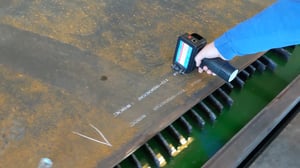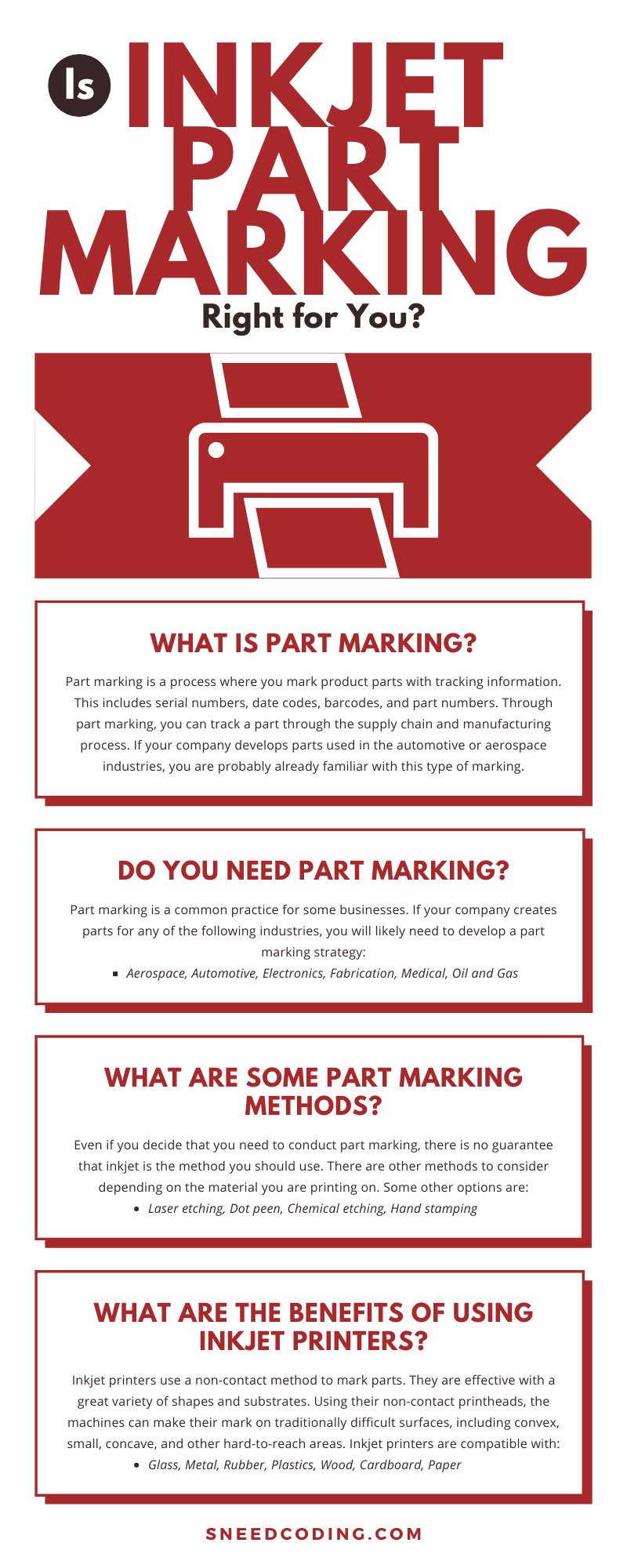
It is not the most glamorous part of manufacturing, but it is necessary in many cases. Part marking is the process where manufacturers tag individual parts with information, so if needed, you can easily identify them. In doing so, you can trace the parts back to them for recall or other purposes.
Manufacturers that are learning the ins and outs of this process have a lot to contend with. Aside from attaining a firm grasp on when to use part marking, there is also the question of what printers and methods to use for the process. Though inkjet printers are a common tool for this work, they are not the only option. Read along and pay close attention to see if this can help answer the question: is inkjet part marking right for you?
What Is Part Marking?
Part marking is a process where you mark product parts with tracking information. This includes can include serial numbers, heat numbers, and part numbers. Through part marking, you can track a part through the supply chain and manufacturing process. If your company develops parts used in the automotive or aerospace industries, you are probably already familiar with this type of marking.
Using part marking, people that buy the parts—like manufacturers or retailers—can isolate the supplier of a faulty piece. This benefits your customers as it lets them know who to contact about any problems with the products. But is also an advantage for you, the manufacturer of the parts, to know which ones are showing problematic signs.
Do You Need Part Marking?
Part marking is a common practice for some businesses. If your company creates parts for any of the following industries, you will likely need to develop a part marking strategy:
- Aerospace
- Automotive
- Electronics
- Fabrication
- Medical
- Oil and Gas
Each of these industries, and many other heavily regulated sectors, has its own rules and regulations determined by their respective bodies. Sometimes the question, “Is inkjet part marking right for you?” is not so much an issue of how you want to conduct your business and more a matter of what laws place on you.
What Are Some Part Marking Methods?
Even if you decide that you need to conduct part marking, there is no guarantee that inkjet is the method you should use. There are other methods to consider depending on the material you are printing on. Some other options are:
- Laser etching: Laser technology is one of the most versatile methods for marking parts. Using a laser printer, you can print on steel, titanium, glass, plastics, wood, and even leather.
- Dot peen: The process for dot peen marking involves using a carbide tip stylus to create stamped dots. It tends to deform the material of organic compounds, but dot peen is an excellent method for steel, aluminum, iron, and nickel alloys.
- Chemical etching: Chemical etching is a good method when the materials are very hard. It can make detailed, relatively inexpensive images.
- Hand stamping: A common marking form in tool-and-die shops, hand stamping is as simple as hammering a stamp into a piece of metal. It is cheap and requires no training, but it is the most time-consuming option.
As you read along and learn more about inkjet printing, think back to these other methods. One of these options is sometimes more applicable to your business.
What Are the Benefits of Using Inkjet Printers?
Inkjet printers use a non-contact method to mark parts. They are effective with a great variety of shapes and substrates. Using their non-contact printheads, the machines can make their mark on traditionally difficult surfaces, including convex, small, concave, and other hard-to-reach areas. Inkjet printers are compatible with:
- Glass
- Metal
- Rubber
- Plastics
- Wood
- Cardboard
- Paper
What Are the Disadvantages of Using Inkjet Printers?
Although handheld inkjet printers have many benefits, they are not always the best option. Inkjet marks print clearly and legibly, but they do not have the same permanence as other options. Inkjet codes can wear away in extreme environments. If you expect your parts to go through substantial physical abuse—either from travel or in their application—laser etching might work better for you.
Should You Go With Inkjet?
At the end of the day, your decision to go with an inkjet printer for your part marking needs will come down to the material you use and the conditions that they are put under. Inkjet printing has its advantages on glass, rubber, plastics, and many other substrates; however, it is not the way to go if you need to deeply engrave the piece of material.
For aeronautics or the automotive industry, where marks are needed on steel parts that are later used in the rigors of a massive machine, it is wise to use an engraving method—like lasers—to imprint the vital pieces of information. However, for parts that do not experience those conditions, like objects made from rubber, plastic, or wood, inkjet printers are the perfect solution.
Summation
As you decide if inkjet part marking is right for you, look back to this blog. These words may help you find the guidance needed to make a final decision. Do your research to find out if your industry requires part marking. Then, once you know whether it is the right road for your business, do some more research to find the correct printer.
In many instances, an inkjet printer is an excellent choice for manufacturers looking to mark their parts. But keep an open mind as you continue your search. See what is out there. You can always contact Sneed Coding Solutions Inc. to see what advice or information we can offer. We want to extend our hand wherever it is needed, to do what we can to #KeepCodingSimple.



